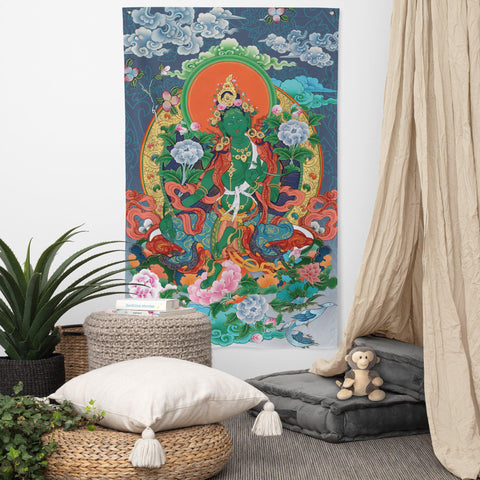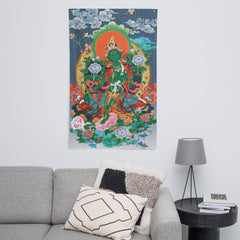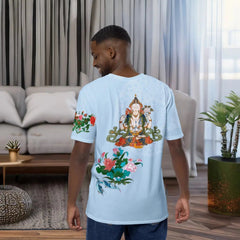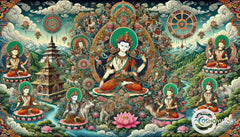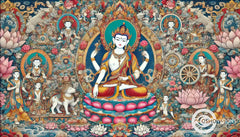Authentic Nepali Thangka Paintings - Traditional Art from Nepal and Tibet
Posted by Massimiliano Geraci
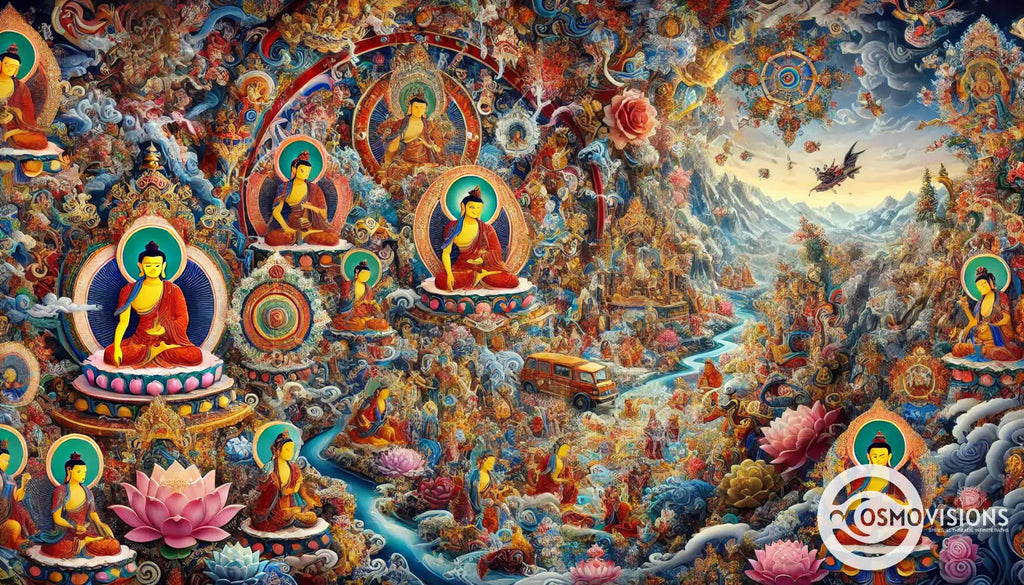
Searching for genuine art can be challenging, especially regarding finding authentic Thangka paintings from Nepal and Tibet. Many are mesmerized by their beauty but struggle to distinguish the real from the imitation.
These traditional pieces of art are stunning and carry deep spiritual significance within every brush stroke.
Remarkably, Thangka painting is a centuries-old tradition that requires artists to follow strict guidelines laid out in Buddhist scripture. This article aims to guide you through the mysterious and particular aspect of Thangka art, teaching you about its history, techniques, and how to identify true masterpieces.
Embrace the journey into traditional Tibetan Buddhism through these sacred paintings.
What is Thangka Painting?
Thangka painting, a traditional art form with deep roots in both Nepali and Tibetan cultures, serves as an important tool for meditation and spiritual instruction. Crafted carefully on cotton or silk canvas, these paintings encapsulate complex Buddhist iconography, featuring Buddha's and Hindu deities.
Essential to the practice of Buddhism and Hinduism across Asia—particularly notable in regions like Kathmandu valley —the thangka thrives on its ability to focus the practitioner’s concentration through visual narratives of enlightenment and the life of the Buddha.
Artists adhere to strict guidelines that dictate every element from color symbolism to deity representation, ensuring each piece is not just art but a vessel for religious teachings.
As they weave intricate details into each work using skill honed over centuries, the thangka becomes more than merely decorative—it emerges as a map guiding devotees on their journey toward enlightenment.
In every stroke lies a prayer; within every color, a mantra.
With this understanding of Thangka's profound purpose and construction in mind, exploring how these sacred wall paintings are created offers insight into their spiritual significance.

Understanding the Basics of Thangka Art
Thangka art serves as a window into the spiritual and cultural life of Nepal and Tibet, intricately weaving Buddhist symbolism with masterful artistic techniques. Artists capture complex philosophies and deities through careful brushwork on cotton or silk canvases, adhering to strict guidelines that have ruled this sacred form of expression for centuries.
Each piece narrates stories from Buddhism, featuring figures like Buddha, Bodhisattvas, goddesses, and gurus set against landscapes or mandalas symbolizing the universe's structure.
These artworks act as aids in meditation and guides for followers seeking enlightenment.
Craftsmen must possess not only outstanding skill but also sufficient religious understanding to accurately depict scenes central to tantric practices and beliefs. The use of vibrant colors derived from natural sources adds another layer of significance, each hue holding its own meaning within Buddhist practice.
This unique combination of artistry and spirituality makes Thangka paintings invaluable tools for teaching and ritual throughout the Himalayan region, fostering a deep connection between viewers and Tibetan Buddhist principles.
Exploring how Thangka paintings are used will further illuminate their role in daily spiritual practice.
How Thangka Paintings are Used
Practitioners use Thangka paintings as tools of inspiration for meditation, guiding the eye and mind toward enlightenment in Buddhism. These works serve as visual aids for spiritual teaching and embody the rich tapestry of Tibetan art and religious philosophy.
Each painting will symbolically represent divinities and knowledge of Buddhist teachings, often focusing on figures like Maitreya or Padmasambhava, important deities in the pantheon of religion.
Devotees meditate upon these images, seeking insights into Abhidharma and paths to achieve a higher state of consciousness.
In their role in personal spiritual practice, Thangka paintings hold a place of honor during various religious ceremonies. Monks carry them in processions to bless the surrounding community; believers look upon them to earn merit (Buddhism) through devotion and reflection.
The Bhavacakra or "wheel of life" featured prominently in many Thanga artworks acts as a moral compass guiding observers through life and the cycles of existence according to Buddhist philosophy.
Transitioning from how Thangka paintings are used illuminates their significance beyond mere objects - they become integral elements within both individual journey towards enlightenment and collective cultural identity.
Different Forms of Thangka Art
Thangka art presents a rich tapestry of forms, each style adhering to strict guidelines yet bursting with creativity. Among these varied expressions, Paubha paintings stand out as a significant style found in Nepal, characterized by their unique depiction of Hindu deities and Buddhist icons.
These artworks serve as spiritual manuals for practitioners, illustrating complex philosophical concepts and meditation techniques through symbolic imagery. The tradition maintains its vibrancy by weaving together elements from the mythic pantheon of religions such as Buddhism and Hinduism.
In Tibet, Thangka paintings often feature Yidam or personal deities and Dakini - celestial female figures revered in Tibetan Buddhism. These thangkas go beyond mere artistic expression; they are tools for teaching and aids in meditation practices.
By incorporating motifs from the Japanese Buddhist pantheon along with figures like Bhrikuti, a goddess venerated in both China and India, Tibetan Thangkas reflect an intricate polytheism that resonates deeply across cultures.
Each piece embodies religious art and serves as a bridge connecting followers to their yidams through visualization practices rooted in centuries-old traditions.
How to Make Traditional Thangka Paintings?
Creating traditional Thangka paintings involves drawing with a blend of spiritual devotion and artistic precision. This process adheres the artist to strict guidelines to ensure each piece radiates the intended spiritual energy.
1. Gather necessary materials, including natural pigments, gold leaf, fine brushes, and cotton or silk canvas.
2. Prepare the canvas through a sequence of stretching and priming it with a mixture of chalk and gesso, creating a smooth surface.
3. Sketch the initial design lightly on the prepared canvas, carefully planning out space for deities and symbolic elements in accordance with Buddhist scriptures.
4. Apply base colors starting from broader areas to finer details; these colors are derived from minerals and plants, grounding the artwork in natural elements.
5. Outline major figures and important symbols using fine brushes to ensure sharpness and clarity in every detail.
6. Decorate with gold leaf in select areas such as halos or ornaments to signify divine light and purity, adhering it carefully onto the painting's surface.
7. Shade and add texture through gradation techniques that bring depth and life to the figures and scenery depicted within the thanka painting.
8. Inscribe Dharma texts or mantras on the back of the canvas, aligning the artwork with spiritual intentions and imbuing it with sacred power.
9. Seal the painting by applying a protective varnish layer that also enhances color vibrancy while ensuring longevity.
Frame or mount the completed Thangka within brocade borders as is traditional, making it ready for display or ritual use.
Throughout this process, artists maintain a meditative focus, embedding each stroke of their brush with prayers and mantras that charge the Thangka with spiritual potency recognized throughout centuries.

Materials and Elements Needed
Crafting an authentic Nepali Thangka painting requires adherence to strict guidelines and a deep understanding of its spiritual essence. Each material and element holds significance, echoing centuries of tradition and spiritual practices.
1. Natural Pigments: Artists use natural pigments derived from minerals, plants, and sometimes even precious metals like gold. These pigments ensure the longevity of the color and vibrancy, in accordance with ancient practices.
2. Cotton or Silk Canvas: The base for Thangka paintings is traditionally a piece of cotton or silk fabric. This choice of material dates back centuries, offering the perfect blend of durability and texture for detailed artwork.
3. Organic Glue: To prepare the canvas and to fix the pigments, a special organic glue made from animal skin or plants is used. This glue does not interfere with the natural colors, ensuring they remain true over time.
4. Gold Leaf: Used especially for depicting sacred figures and symbols, gold leaf highlights the divine nature of the subjects represented in Thangka art.
5. Brushes Made from Animal Hair: Fine brushes crafted from the hair of animals such as goats or horses are preferred for their ability to create precise lines essential for intricate details.
6. Wooden Frame: A sturdy wooden frame is required to stretch and secure the canvas before the painting begins, maintaining tension throughout the process.
7. Charcoal Dust: Artists outline preliminary sketches using charcoal dust, allowing for corrections before finalizing designs with pigments.
8. Pantheon Reference Texts: Authentic Thangka paintings follow strict guidelines based on Buddhist scripture; artists often reference ancient texts to ensure accuracy in depicting various deities within the Buddhist pantheon.
9. Veterans’ Knowledge: The expertise of seasoned Thangka artists plays a critical role in maintaining authenticity and quality. Their knowledge on blending pigments in accordance with traditional methods is invaluable.
10. Meditation and Rituals: Before starting a Thangka painting, artists engage in meditation or perform specific rituals to purify their minds and intentions, aligning their work with spiritual practice.
11. Patience & Precision Instruments: Creating Thangka art demands patience and tools that allow for detailed workmanship - instruments like fine-pointed pens made from bamboo are essential.
12. Protective Sealants: Finally, once completed, Thangkas are treated and painted with protective sealants derived from natural resins to shield them against moisture and sunlight damage.
Each element contributes uniquely to the creation of a Thangka painting, embodying centuries-old traditions while adhering to strict religious guidelines. Through this combination of materials and elements steeped in spirituality, authentic Nepali Thangka paintings continue to be revered works of art that transcend mere aesthetic value.
Step-by-Step Guide to Painting Thangkas
Having gathered the necessary materials and elements for creating a Thangka painting, one begins the process of actually bringing these divine images to life. The process adheres to strict guidelines and is steeped in centuries-old traditions that ensure each piece's authenticity and spiritual resonance.
1. Select a suitable canvas made from cotton or silk, preparing it with a mixture of animal glue and white clay which creates a smooth surface for detailed work.
2. Sketch the desired image lightly on the prepared canvas, using charcoal or pencil; this step must be in accordance with traditional proportions and iconography specific to Thangka art.
3. Create a border around the sketch, often framed with brocade, serving as an aesthetic boundary and protective layer for the painting.
4. Mix mineral pigments with water and a binding agent (such as egg yolk), ensuring colors adhere strongly to the canvas while maintaining their vibrancy over centuries.
5. Apply colors starting from the background to foreground elements, progressing from lighter to darker shades to establish depth.
6. Embellish the painting with gold leaf, highlighting divine aspects of figures like halos or ornaments, symbolizing enlightenment and purity found within Buddhist scripture.
7. Put final touches on details such as facial expressions and finer elements of clothing using thin brushes; these features require steady hands and a deep understanding of the symbolic meanings behind each depiction.
8. Perform consecration rituals to infuse the completed Thangka with spiritual energy; these ceremonies involve chants, prayers, and offerings in accordance with Buddhist guidelines.
9. Preserve the Thangka by rolling it onto wooden scrolls under silk coverings when not displayed; this protects its intricate details from damage due to exposure.
Throughout this intricate process, artists maintain a meditative focus that reflects their deep devotion and respects for the pantheon depicted in their work. This dedication ensures that every Thangka serves as an object of visual beauty and a profound tool for meditation and spiritual practice.
Common Techniques Used in Thangka Painting
Transitioning from the detailed process outlined in the step-by-step guide to painting Thangkas, we now explore the distinctive techniques that breathe life and vibrancy into these traditional artworks. Mastering these methods requires a deep understanding of the art form and a spiritual connection to its rooted traditions and cultural significance.
1. Grid Method: Artists begin with a precise grid layout, drawn in accordance with strict guidelines to ensure accuracy in dimensions and proportions. This technique is foundational, serving as the skeleton upon which the intricate details of deities, symbols, and mandalas are layered.
2. Gold Application: A hallmark of genuine Thangka paintings involves the application of real gold dust or thin sheets of gold leaf. This symbolizes purity and sacredness within the artwork, often used to highlight important figures or elements, enhancing their divine presence.
3. Pigment Preparation: Traditional artists hand-grind organic pigments from minerals and plants, adhering to centuries-old recipes for achieving vibrant hues that hold symbolic meanings. Each color employed is charged with specific attribute represents Buddhist teachings and principles.
4. Line Work: Employing fine brushes made from animal hair, artists execute delicate line work that defines shapes and adds detail. This requires a steady hand and profound patience, as some Thangkas can take months or even years to complete.
5. Shading Technique: To achieve depth and volume within the imagery, Thangka painters skillfully blend gradients of colors using water-based techniques similar to those found in other East Asian traditions but uniquely adapted for spiritual representation in accordance with Buddhist scripture.
6. Iconography Adherence: Every element painted follows predetermined iconographic codes derived from ancient texts and guidelines related to Buddhism's pantheon (religion). These icons include various Buddhas, deities associated with yoga practices, symbols representing aspects of enlightenment, and more detailed illustrations depicting narratives from Buddhist scripture.
7. Attachment Method: Finally, once completed, the painted canvas is traditionally mounted on silk brocade frames—a process involving precise folding techniques—to prepare it for hanging during religious ceremonies or meditation practices.
These techniques underscore an artist’s dedication towards creating aesthetically pleasing art and reflect deeper adherence to spirituality's role within Nepali culture across centuries. Through mastering these methods in accordance with strict guidelines passed down through generations, artists continue to contribute immensely towards preserving this sacred art form.
What is the History of Thangka Painting in Nepal?
The origins of Thangka painting in Nepal trace back to the 7th and 8th centuries, a time when Nepali artists began crafting these detailed and intricate artworks. These paintings served as mediums for meditation, offering spiritual guidance to those who engaged with them.
The art form flourished under the patronage of Malla kings from the 12th to the 18th century, marking a significant era that saw advancements in techniques and huge variety styles to Nepali Thangka.
Artists from various monastic communities devoted their lives to perfecting this craft, embedding deep religious significance into each brushstroke.
Throughout each century, Thangka paintings have played a pivotal role in preserving Buddhist teachings and iconography. They encapsulate complex philosophical ideas and narratives central to Buddhism, making these sacred texts accessible through visual storytelling.
Each piece is rich with symbolism; deities are depicted with precise iconography that adheres strictly to guidelines laid out in ancient Buddhist scripture. This adherence ensures that every Thangka serves as an authentic embodiment of Buddha's teachings.
As custodians of this ancient tradition, Nepali artists continue hard work and to pass down their skills generation after generation, maintaining the art's integrity while adapting subtly over time.
Thangka paintings are a window into the soul's journey toward enlightenment.
Origins and Early Development
Thangka painting, a revered tradition nestled in the spiritual landscapes of Nepal and Tibet, traces its roots back to ancient Buddhist practices. Originating over a thousand years ago, these intricate artworks served as important teaching tools that represents Buddha’s life stories, various influential lamas, and other deities worshipped in Buddhism.
Craftsmen integrated their understanding of Buddhist philosophy with their artistic skills to create thangkas that are not just visually stunning but also rich in religious significance.
The early development of Thangka paintings was closely tied to the spread of Buddhism throughout Asia. Monks and scholars traveled long distances carrying these paintings on fabric, which made it easier to establish new monasteries and spread Buddha's teachings.
This mobility contributed significantly to the popularity and evolution of the greatest art forms across different regions. Each piece held substantial price beyond its aesthetic appeal; it was an essential medium for preserving religious texts and meditation practices among followers.
Evolution Over Centuries
Over centuries, Thangka paintings have journeyed through an extraordinary transformation. Initially rooted in the spiritual practices of Tibet in the 7th century, these paintings became vital for Nepali monastic life by the 11th century.
Artists began to weave complex narratives of Buddhist philosophy within their works, making each piece not just art but a visual scripture. The complexity of designs and depth of symbolism grew with each era, reflecting changes in religious thought, social hierarchies, and external influences from neighboring regions.
By the 14th century, this art form had matured significantly in Nepal, incorporating local styles and techniques that distinguished it from its Tibetan predecessors. Innovations such as the use of mineral pigments gave Thangka paintings from this period a distinct vibrancy never seen before.
This evolution was not static; it mirrored the dynamic shifts within Nepalese society and its relationship with spirituality. As we turn our gaze to understanding the main elements present in Thangka painting today, these historical shifts provide crucial context for their symbolic richness.
The Role of Thangka Paintings in Nepali Culture
As the evolution of Thangka paintings unfolded over centuries, their pivotal role in Nepali culture became undeniable. These intricate artworks serve as more than just decorative pieces; they are profound spiritual tools in Buddhism, deeply intertwined with the practice and dissemination of religious teachings.
Thangka paintings are utilized in meditation to aid practitioners in visualizing deities, understanding Buddhist philosophies, and achieving higher states of consciousness.
Thangkas hold a unique position in Nepali households as well, acting as protective amulets that bless homes with peace and prosperity. During important festivals and religious ceremonies, these paintings are displayed with reverence, connecting people with their heritage and the divine.
Through every stitch and brushstroke, artisans preserve ancient traditions while contributing to the cultural identity of Nepal.
In every color and line lies a story of faith and tradition.
What Are the Main Elements in a Thangka Painting?
Thangka paintings hold a universe of symbolism, with deities being central figures that guide the observer into understanding Buddhist principles and teachings. These luminous beings vary from wrathful to peaceful forms, each carrying profound meanings about the wheel of life one’s spiritual journey.
Artists carefully paint these divine entities, embedding energies believed to benefit all who gaze upon them.
Another essential element in Thangka art is the mandala, representing the cosmic order and mental clarity. Budding from ancient texts, its geometric precision serves as a tool for meditation, guiding individuals towards enlightenment.
Surrounding this sacred circle are often intricate details of Buddhist scripture and iconography, setting guidelines for ethical living and spiritual development.
Symbolism and Deities
In Thangka paintings, every color, shape, and aspect of figure has a deeper meaning. Artists choose specific deities to represent various aspects of life and spirituality. For example, Green Tara is often depicted to symbolize protection from fear and obstacles. White Tara is linked with maternal compassion and healing.
Likewise, the Medicine Buddha embodies healing of physical and mental illnesses. These figures serve not just as art but as spiritual guides for meditation and reflection.
Symbols like the lotus flower signify purity and enlightenment, emerging unscathed from murky waters. The eight auspicious symbols, including the endless knot and the golden fish, convey messages and visions of harmony, fortune, and eternity within these sacred artworks.
Through careful analysis of these elements, one gains insight into Buddhist teachings and philosophies guiding daily practices for liberation and wisdom.
The Mandala and Its Significance
The Mandala serves as a spiritual and ritual symbol in both Hinduism and Buddhism, representing the universe. In Thangka paintings, it assumes a critical role, embodying complex symbolism through intricate geometric patterns.
These patterns are not mere decorations but are laden with deep meanings, each shape, color, and line conveying messages about the cosmos and human existence. Artists craft Mandalas with precision and intentionality, guiding viewers into meditative contemplation.
The use of vibrant colors and detailed designs in these circular diagrams aids practitioners in focusing their minds during meditation sessions.
This significance extends beyond its visual appeal; the Mandala encapsulates philosophical principles central to Tibetan Buddhism. It acts as a map for enlightenment, illustrating the enlightened mind's structure through symbolic representation of palaces where deities reside.
Creating or viewing a Mandala offers a journey towards inner peace and liberation from cycles of rebirth (samsara). As such, Mandalas hold an esteemed place within Thangka artistry—not just for their beauty but for facilitating spiritual growth and understanding among followers.
The exploration of Tibetan Buddhist painting offers further insight into how these artistic elements intertwine with religious practice.
Buddhist Scripture and Guidelines
Buddhist scripture and guidelines deeply influence Thangka paintings, embedding spiritual wisdom within every stroke. Thangka artists turn to ancient texts for inspiration, ensuring their creations are not just visually stunning but also spiritually significant.
These scriptures outline the representations of deities, mandalas, and symbols, each with its own set of rules on proportions and colors. This adherence to religious doctrine ensures that every Thangka painting serves as a tool for meditation and a guide on the path to enlightenment.
Artists carefully follow these guidelines to create artworks that are both authentic and meaningful. The precision in depicting the Buddha's life events or the intricate designs of mandalas reflects a profound respect for tradition.
Through this disciplined practice, Thangkas become more than just paintings; they emerge as vibrant links between earthly existence and spiritual ideals.
Thangka art transcends mere aesthetics, becoming a bridge to higher understanding.
How to Identify Authentic Thangka Paintings?
To identify authentic Thangka paintings, one must first examine the style of paint and the materials used. True traditional thangkas are painted on natural canvas, primed with a mixture of hide glue and white clay, creating a smooth surface for detailed work.
Artists deploy mineral and organic pigments derived from sources such as blue lapis lazuli for blues and malachite for greens, ensuring the colors remain vibrant over centuries. Authentic pieces also frequently incorporate gold, applied with great care to highlight details or create an aura around deities.
The iconography in genuine Thangka paintings adheres strictly to Buddhist scripture, featuring symbolic elements like the lotus flower representing purity or specific mandala designs symbolizing the universe.
Skilled artisans undergo years of training to master these complex symbols and composition rules. The precision in depicting deities - each with their distinct attributes and postures - further distinguishes original works from imitations.
Moreover, the back of a true Thangka often bears seals or signatures of the monastery or artist, providing provenance that attests to its authenticity and religious significance.

Recognizing Genuine Artworks
Authentic Thangka paintings carry the essence of Tibetan and Nepalese spirituality and culture. Identifying genuine artworks requires a blend of knowledge, attention to detail, and an understanding of traditional practices.
1. Examine the materials used: Authentic Thangkas are painted on natural cotton canvas or silk appliqué, employing mineral and organic pigments derived from stones, plants, and metals.
2. Investigate the iconography: Genuine Thangka paintings adhere strictly to symbolic representations established by centuries-old Buddhist texts. Each deity, mandala, or symbol follows precise guidelines regarding form, color, and posture.
3. Look for signs of age: While new Thangkas are still being produced, older pieces often have a soft patina and wear that suggest genuine age. However, some modern replicas can be artificially aged, so this should not be the only indicator used.
4. Assess the quality of artwork: Traditional Thangkas require years of training to produce. Intricate details, fine lines, and balanced compositions usually indicate a skilled artist's hand.
5. Understand the significance of signatures: Many master artists sign their work using symbolic stamps or in script within the painting. An understanding of these signatures can help authenticate a piece.
6. Ask for provenance or history: Reliable sellers can often provide a history for the artwork, including its origin, previous ownerships, and associated temples or monasteries.
7. Consider the price as an indicator: While not always accurate on its very own—high-quality authentic Thangkas will generally command higher prices due to their spiritual significance and craftsmanship involved.
8. Verify with experts if possible: Specialists in Himalayan art or reputable galleries can offer valuable insights into whether a Thangka is genuine.
9. Look at religious accuracy: Deviations from established Buddhist iconography might suggest that the painting is not an authentic ritual art piece but rather made for tourists.
10. Conduct material tests when permitted: Scientific analysis can determine age and materials' authenticity though it's rarely practical outside museum acquisitions or high-value transactions.
11. Be aware of modern printing techniques: Some reproductions use digital printing on canvas; check for pixelation or ink patterns indicative of a printed image process rather than hand-painted detail.
12. Seek consistency in aging effects across all elements of the painting; inconsistent wear might reveal composite pieces from different times stitched together to appear ancient.
Each step plays a crucial role in discerning true Nepali Thangka paintings from those that mimic tradition without embodying its cultural depth and spiritual integrity.
Understanding Price and Value
Deciphering the price of authentic Nepali Thangka paintings requires a deep understanding that transcends mere monetary value. The cost attached to these traditional artworks does not solely denote its financial worth but also encompasses the spiritual significance, the artists' dedicated labor, centuries-old techniques passed through generations, and the rich cultural heritage each piece represents.
Determining their value involves acknowledging the careful craftsmanship, where an artist might invest months or even years in creating a single painting using natural pigments and gold leaf on cotton or silk canvases.
Assessing the authenticity and intrinsic worth of Thangka paintings calls for specialized knowledge in identifying genuine pieces. Key factors include scrutinizing the quality of materials used, evaluating the finesse in detail work, understanding symbolic meanings embedded within every brush stroke, and appreciating historical lineage linking back to ancient Buddhist practices.
Buyers should consider these aspects alongside price to ensure they are not merely acquiring an art piece but are investing in a fragment of Nepal’s spiritual legacy and artistic tradition.
Importance of Religious and Cultural Knowledge
Grasping the religious and cultural significance behind Thangka paintings is crucial for anyone looking to fully appreciate these intricate masterpieces. Religious and cultural knowledge acts as a bridge that connects viewers with the deep spiritual meanings embedded within each brushstroke.
For many thanka art lovers, anthropologists, and spirituality enthusiasts, understanding the symbolism of deities, mandalas, and scripture in Thangka art opens up a new dimension of appreciation.
It allows one to see beyond the physical beauty of the artwork and into its soulful purpose – serving as an aid for meditation and spiritual growth.
Art collectors face fewer risks of acquiring counterfeit pieces online when they possess insightful knowledge about Thangka's religious connotations and historical background. They can discern genuine artworks from imitations online by recognizing authentic symbols and motifs specific to Nepali Buddhist culture.
Furthermore, this comprehension enriches their experience by connecting them more deeply with Nepali traditions and beliefs underlying such stunning visual narratives. This journey into Thangka’s spiritual ethos enhances one's aesthetic enjoyment and fosters a deeper respect for Nepal's rich artistic heritage.









